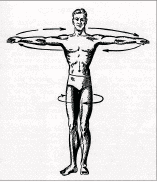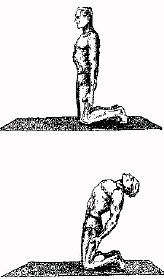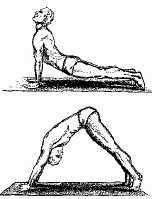The Five Tibetan Rites is a yoga routine based on a ritual of exercises
discovered in the early 1900's, by a British army colonel, Colonel Bradford,
who was living in a Himalayan monastery. They are practiced around the world
and are said to prevent aging. In 1939, Peter Kelder published "The Original
Five Tibetan Rites of Rejuvenation"
The rites are comprised of five different movements (with a sixth added for good
measure), with each movement performed up to 21 times (Tibetans believe 21 is a
perfect, mystical number). Start with 3 repetitions of each exercise and
gradually increase the repetitions. Entire routine can be completed in less than
10 minutes.
For thousands of years, medical practitioners have maintained that the body has seven principal energy centers which correspond to the seven endocrine glands, also known as chakras. Chakras are essentially energies within spinning vortexes. As a vortex is increased, the life force becomes stronger and more directed.
Recent medical research has uncovered convincing evidence that the aging process is hormone-regulated. The five ancient Tibetan rites are said to normalize hormonal imbalances in the body, thereby holding the key to lasting youth, health, and vitality. The rites stimulate the energy system in the body, wake up the chakras, and get energy moving from your core outward to your extremities. The theory behind the rites is that your Kundalini (spiritual energy) is stored and lies at the base of your spine and that these rites access that energy in a very efficient, fast, and user-friendly way.
An important part of the Tibetan exercises is a conscious synchronization of breathing while performing physical activity. Before beginning the exercises, practice the basic 4 - stage breathing technique:
Inhale | Hold filled lungs | Exhale | Hold empty lungs.
No exercise should be so intense that it makes you feel exhausted. For example, if you are "losing your breath", it indicates that your body is in an anaerobic (low oxygen) condition and that you should slow down. If you can not talk normally after performing an exercise, you should slow down. When performing the exercises, the main emphasis should be on breath synchronization and fluency, rather than on speed and number of repetitions.
Some call these rites isometric exercises. Although they are helpful in stretching muscles and joints and improving muscle tone, this is not their primary purpose. A slow vortex causes that part of the body to deteriorate, while a faster one causes nervousness, anxiety, and exhaustion. Abnormal vortexes produces abnormal health, deterioration, and old age. The rites normalize the speed of the spinning vortexes by keeping them spinning at the same rate and working in harmony.
Affirmations during rites
1. I am full of energy | 2. My mind is clear and calm | 3. I am flexible and receptive
4. I am strong and balanced | 5. I am positive and motivated
The first rite is the practice of spinning, which affects the emotional body by speeding up the vortexes. Children naturally spin while playing. As one spins clockwise, Lamas say that negative residues are flung out of the body and the bridge is strengthened between the left and right hemispheres. Spinning stimulates the body's energy system and wakes up the chakras.
|
Spinning:
Extend arms out to sides and spin (in a clockwise direction). Go as fast as you
can without losing control (slow down or stop if get dizzy). Try 21 revolutions.
Follow right arm so that you spin around to the right. As you begin to spin,
focus vision on a single point straight ahead and continue holding vision on
that point as long as possible. Eventually have to let it leave field of vision
as head spins with body. As this occurs, turn head around quickly and refocus on
reference point as soon as possible. Using a reference point helps prevent
dizziness. Stop spinning as soon as feel slightly dizzy. Lie on floor and breathe
deeply before begin next rite. Raise hands above head to stretch back.
Lamas do not carry whirling to an excess. While the whirling dervishes may spin hundreds of times, the Lamas only do it 21 times, just enough to stimulate the vortexes into action.
|

|
Rite two is similar to Western abdominal exercises. By raising head to chest,
you create an extra stimulus to solar plexus chakra and
"conception vessel" moving through the center of trunk.
Use thick pad to protect back as you lie on floor.
Leg Raises:
Lie flat on floor, face up. Fully extend arms along sides, place palms against
floor, keeping fingers close together. Raise head off floor, tucking chin
against chest. As you do this, lift legs, knees straight, into a vertical
position. If possible, let legs extend back over body, toward head; do not let
knees bend. Slowly lower both head and legs, knees straight, to the floor.
Allow all muscles to relax, continue breathing in the same rhythm. Breathe in
deeply as lift legs and breathe out as lower legs.
Upon sitting up, stretch legs out in front of you. Starting at thigh area,
stroke down outside of legs with hands until reach feet. Grab feet on the
outside, pulling head as close to straight knees as possible
|

|
Rite three opens solar plexus and heart. We begin life by drawing energy in
through the umbilical
area. Lamas believe we continue habit of sucking into the solar
plexus, which is seat of the emotional body, without being aware of what we are
taking in. All kinds of emotional energies enter in this way. Psychically, we
attract negative emotions that relate to those we ourselves are carrying. Thus,
fear or anger inside us acts as a magnet to people who are carrying the same
kind of energies.
Contraction interferes with the functioning of solar plexus ganglion that relays messages to the brain relevant to our sense of safety and stimulates the "fight or flight" reflex. This rite provides an extension and a powerful lifting of the entire trunk, which is the opposite of a defensive, contractive stance. By performing this motion, you are reversing the energy flow and raising the energy to the heart area.
Camel:
Classic back bend. Kneel on floor, knees under hips, toes flat, body erect.
Place hands on back of legs just under buttocks. Tilt head and neck forward,
tucking chin against chest. Tilt head and neck backward, arching spine backward,
and look upward. After arching, return to original position, repeat up to 21
times.
Inhale deeply as arch spine, exhale as return to erect position. This rite opens
up the front of body and spine. Establish a rhythmic breathing pattern. Breathe
in deeply as arch spine. Breathe out as return to erect position.
When finished extend arms at shoulder level straight out in front, lean back
without arching back. Will feel this stretching facia lata
at outer thighs.
|

|
Rite 4 causes a pleasant stimulation throughout sacral area which stirs the
meridians and energies going to and from groin and down legs. Strengthens and
tones legs and glutes
|
Tabletop: Sit on floor with legs extended, body erect, feet flexed and
about 12 inches apart, palms flat on floor next to hips, fingers pointed toward
feet. Tuck chin forward against chest. Tilt head backward as far as it will go.
At same time, bend knees and push up to a "tabletop" position, arms straight. Let
head fall back gently. Trunk of body will be in a straight line with upper legs,
horizontal to floor. Tense every muscle. Relax muscles as return to original
sitting position. Rest before repeating procedure.
Breathe in as raise up, hold breath as tense muscles, breathe out completely as
come down. Continue breathing in same rhythm as long as you rest between
repetitions
|

|
Rite five brings an immediate change in energy currents of the body. It makes
one feel strong and invigorated and brings a happy glow to face. Most powerful
rite in terms of speeding up chakric vortexes
|
Up Dog & Down Dog: Begin on all fours, toes flexed, palms on floor,
weight distributed evenly among knees, palms, and balls of feet. Throughout this
rite, hands and feet should be kept straight. Start with arms perpendicular to
floor, and spine arched downward, so that body is in a sagging position. Slowly
lift buttocks toward sky, with a flat back, lowering head, so body makes an
inverted "V." Tuck chin to chest. Pause, then lower buttocks while
pressing palms into floor, until legs are in a plank position (parallel to the
ground), moving chest out and shoulders back. Inhale on way up; exhale on way
down. Repeat, up to 21 times. In the rite, body is moving in concert, moving
energy up the spine
Follow deep breathing pattern used in previous rites. Breathe in deeply as raise
body, breathe out fully as you lower it
|

|
Rite 6. Tibetans say this special sixth rite will make one into a super-being.
Deep Breathing: Stand comfortably and exhale as bend from waist, placing
hands on knees. Expel last bit of air from lungs, without taking in new breath
return to erect position. Place hands on hips, with fingers to front and press
as hard as you can while sucking in abdomen. Will raise shoulders and chest.
While holding in abdomen, squeeze pubococcygeal
muscle up to emphasize upward thrust. Hold position and bring closed eyeballs to
the point between eyebrows so that all this lower chakric energy will rise up to
the highest centers. When you must take a breath, breathe in through nose and
exhale through mouth as drop arms down to sides to relax. Take in several
normal breaths through nose and mouth before beginning again.
Other Tibetan Exercises
Simple Spine Stretch
Facilitates energy throughout spinal column and increases flexibility of neck,
which brings you into a deep state of relaxation and facilitate meditation.
Sit cross-legged, place palms down on knees, slowly turn head to gaze over one
shoulder. As you do this will feel pleasant stretching and twisting of spine.
Breath in as turn neck over shoulder and exhale while returning to center.
Repeat in other direction, continue several times. Create an even rhythm with
breathing and movement.
To strengthen digestion and bring balance and harmony while increasing vitality:
Sit cross-legged and straight-backed as comfortably, place hands on knees with
fists clenched and palms up. Keeps energy circulating, rather than dispersing
it. Run tongue from left corner of mouth, across gums, and up around roof to
draw a circular path. Is counter-clockwise motion. Repeat 36 times until mouth
is full of saliva.
Swallow saliva in three parts, which represent heaven, earth and man. It should
be a vigorous swallow with intent to send it down into abdomen. Listen for
sound of saliva in belly. Repeat two to three times.
The Turtle
Stimulates all the nerves bringing energy in and out of brain while relaxing and
opening neck area. Neck is vital as a passageway of central nervous system and
thus is key to our entire body. All Yang meridians converge at base of the neck
behind head, which makes it a powerful place of protection to body. Esoterically,
neck is the place where we hold our will. If we make neck more fluid and
flexible, may change rigid perspectives that causes us so much difficulty in
life. The Turtle exercise opens throat area and stretches spine while
strengthening and dissolving tiredness and stiffness of neck and shoulder muscles.
Important to do this slowly in rhythm you imagine a Turtle would use.
Inhale as touch chin to chest. Feel stretch on back of neck and let shoulders
relax downward. Bring shoulders up toward ears like a Turtle pulling back into
its shell while you begin to exhale slowly as tilt head back to rest on back of
neck. Repeat at least twelve times. Should be practiced in concert with two
other motions, which greatly influence endocrine glands and chakras.
First Motion:
As lift neck in exhalation, squeeze anal sphincter as if stopping flow of urine.
This is action of the all-important pubococcygeal muscles that
strengthen pelvic floor. Hold pubococcygeal muscle tight until again
bring chin down during inhalation. Relax while inhale. As become proficient at
combining these internal and external motions, can hold pubcoccygeal
muscle through one or two whole cycles.
Second Motion:
Rub breasts for women and lower abdomen for men, in unison with the rest of
the exercise. Seems complicated at first and demands some effort to master.
Men:
Place both hands, fingers downward, over lower abdomen just above
pubic
bone. As you execute the Turtle, rub both hands in a clockwise motion from
pubic bone to the right, up to belly button, and down left side back to
pubis.
Do until feel heat in lower abdominal area.
Women:
Place hands with fingers facing down towards
pelvic bone,
between breasts. Starting with fingers between nipples, rub up and outward to
each side of breasts, down around and up through to starting position, having
traced all the way around breast. Do this about three times as fast as you do
the rest of Turtle moves, about thirty-six times to the twelve motions of the
Turtle. Once have arrived at perfect hormonal and physical balance, will no
longer need to do rubbing part of exercise. This exercise is contraindicated
during menstruation because at that time will be wanting energy to flow out
of body, not up. Common who practice this exercise daily to stop menstruating.
Should give you a clue about how powerful these internal exercises are in terms
of regulating the flows of bodily energies.
After completing Turtle, body will be relaxed and balanced. Good starting point for
meditation, as focus and consciousness will be deep within.
Chakras Crown-Pituitary Brow-Pineal Throat-Thyroid Heart-Thymus Solar Plexus-Adrenals
Splenic-Gonads Root-Suprarenal




